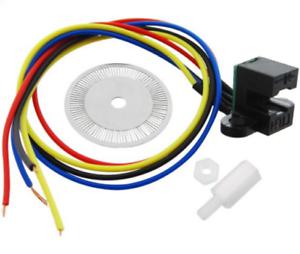Photoelectric encoder
Introduction
According to the detection principle, encoders can be divided into optical, magnetic, inductive and capacitive. According to its scale method and signal output form, it can be divided into three types: incremental, absolute and mixed. (REP)
Principle
The photoelectric encoder uses the principle of grating diffraction to realize displacement-digital conversion. Through photoelectric conversion, the mechanical geometric displacement on the output shaft is converted into pulse digital quantity. Sensor.
Common photoelectric encoder is composed of grating disc, light-emitting element and photosensitive element. The grating is actually a disc engraved with regular light-transmitting and opaque bars. The light flux received by the photosensitive element changes synchronously with the light-transmitting bars. The output waveform of the photosensitive element is reshaped and becomes a pulse signal. It outputs One pulse. According to the pulse change, the displacement of the equipment can be accurately measured and controlled.

Incremental encoder
Incremental encoder directly uses the principle of photoelectric conversion to output three sets of square wave pulses A, B and Z phases; A, B two sets of pulse phases The difference is 90°, so that the direction of rotation can be easily judged, and the Z-phase is one pulse per revolution, which is used for reference point positioning. It has the advantages of simple principle structure, average mechanical life of more than tens of thousands of hours, strong anti-interference ability, high reliability, and suitable for long-distance transmission. The disadvantage is that the absolute position information of the shaft rotation cannot be output.
Absolute encoder
The absolute encoder is a sensor that directly outputs digital quantities. There are several concentric code tracks along the radial direction on its circular code disc. Light-transmitting and non-light-transmitting sectors are alternately formed. The number of sectors of adjacent code channels is doubled. The number of code channels on the code disc is the number of binary digits. On one side of the code disc is the light source. There is a photosensitive element corresponding to each code track on the other side; when the code disc is in different positions, each photosensitive element converts the corresponding level signal according to whether it receives light or not to form a binary number. The characteristic of this kind of encoder is that it does not need a counter, and a fixed digital code corresponding to the position can be read out at any position of the shaft. Obviously, the more code channels, the higher the resolution. For an encoder with N-bit binary resolution, the code disk must have N code channels.
The absolute encoder uses natural binary or cyclic binary (Grey code) method for photoelectric conversion. The difference between an absolute encoder and an incremental encoder is the transparent and opaque line pattern on the disc. The absolute encoder can have several codes, and the absolute position can be detected according to the code on the read code disc. The coding design can adopt binary code, cyclic code, two's complement code, etc. Its characteristics are:
1.2.1 can directly read the absolute value of the angle coordinate;
1.2.2 has no cumulative error;
1.2.3 power supply The position information will not be lost after removal. However, the resolution is determined by the number of bits in the binary system, which means that the accuracy depends on the number of bits. There are currently 10 bits, 14 bits, and so on.
Hybrid absolute encoder
Hybrid absolute encoder, it outputs two sets of information: one set of information is used to detect the magnetic pole position, with the function of absolute information; the other The group is exactly the same as the output information of the incremental encoder.
The photoelectric encoder is an angle (angular velocity) detection device. It converts the angle input to the shaft into the corresponding electric pulse or digital quantity by using the photoelectric conversion principle. It has a small size and high accuracy. Reliable work, digital interface and other advantages. It is widely used in devices and equipment that need to detect angles such as CNC machine tools, rotary tables, servo drives, robots, radars, and military target determination.
Latest: Homogeneous competition
Next: Solid-state laser







